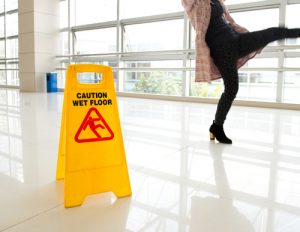The risk of injuries goes up with age, but this happens earlier than people think. These fall-prevention practices are ones that everyone over 40 should follow to stay safe.
Fall-prevention practices are sometimes viewed as something that only older adults and toddlers need to worry about. However, recent research has shown that a person’s fall risk goes up starting around the age of 40. This is most prevalent for women, but it can be understood that men are also at a higher risk for fall-related injuries. Knowing how to implement practices to prevent falls now helps you stay safer as you age.
Fall-Prevention Practices You Should Follow
Clear Out Dangerous Clutter
Tripping over objects in your path is a common cause of falls. Look at all of the floors around your house. Are there cords in the way or furniture legs that jut out into the walking path? These types of tripping hazards increase your risk of falling at home. Keep in mind that clutter also includes things such as pet toys or shoes left in the wrong place.
Light Your Walking Paths
Installing more lighting is one of the simpler fall-prevention practices that you can follow, and it makes a dramatic impact. Start by checking outside to see if you need more lights to find your way inside after arriving home at night. Then, move to the hallways and other darker areas of your home. Motion-sensitive light systems are a great way to have lights come on when you need them the most but may not be able to access a switch.
Wear the Right Clothing and Footwear
People sometimes fall due to restrictive or loose clothing. Try to wear clothes that won’t get hung up on objects that you walk by. While you want your clothing to be fairly snug, you also want to avoid wearing things that are too tight that could restrict your movement. Finish this up by checking your shoes. Ideally, your shoes should have non-skid soles and fit your feet well.
 Focus on Wet Areas for Your Fall-Prevention Practices
Focus on Wet Areas for Your Fall-Prevention Practices
The majority of fall-related injuries occur during accidents that involve a person’s being on a slippery surface such as in the bathroom or kitchen. Make sure to add non-skid mats to floor surfaces where water is likely to fall. Grab rails in the bathroom give you an additional way to stabilize your body during movements on slippery surfaces.
Stay Physically Active
All of this talk about falling might have you rethinking your exercise routine. The good news is that regular physical activity helps you maintain the muscle strength and balance you need to stay upright. If you do participate in risky activities, such as hiking outdoors or bicycling, then take the appropriate precautions. Wearing a helmet during cycling or carrying a walking stick during a hike can help you stay safe. You can also add new elements to your workout regimen that promote balance. Yoga, Pilates and tai chi are a few options that help you improve your coordination.
Think Through Potentially Hazardous Activities
One of the most important things you can do to prevent falls is to recognize your risk. People who take medications that affect their balance are at a higher risk for falls, and you should be more cautious if you already face mobility challenges. Always assess new tasks from this standpoint. If it seems unsafe to climb a ladder or walk across a wet floor, then ask for help.
Assess Your Practices Over Time
It is normal to slowly need to implement more of these practices as you age. Take time every few months to make sure that what you are doing is working. Occasionally, you’ll find that you might need to add things such as a raised toilet seat or more lighting to help you navigate new challenges that threaten your safety.
Younger adults can still experience life-altering injuries after falling at home. The aging process begins long before the age of 65, which means that you need to start thinking about fall-prevention practices as early as your 40s. Doing so gives you a stronger chance of making it to your senior years with a strong and healthy body.

 Focus on Wet Areas for Your Fall-Prevention Practices
Focus on Wet Areas for Your Fall-Prevention Practices



